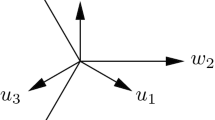Abstract
A de Bruijn torus is the two dimensional generalization of a de Bruijn sequence. While methods exist to generate these tori, only a few methods of construction are known. We present a novel method to generate de Bruijn tori with rectangular windows by combining two variants of de Bruijn sequences.


Similar content being viewed by others
Data availability
The datasets generated during the current study are available from the corresponding author on reasonable request.
Notes
The last row and column are adjacent to the first row and column respectively.
\(\Pi \) being the rotations on strings of length r
Here we use the variable convention in [4].
i.e. we apply the cumulative rotations on each string.
It is unknown how many de Bruijn families exist.
Recall that i represents \(\pi _i\) etc.
References
Bruckstein Alfred M., et al.: Simple and robust binary self-location patterns. IEEE Trans. Info. Theory 58(7), 4884–4889 (2012). https://doi.org/10.1109/TIT.2012.2191699.
Burns J., Mitchell C.J.: Coding schemes for two-dimensional position sensing. Technical Publications Department, Hewlett-Packard Laboratories (1992).
Chartrand G., Lesniak L., Zhang P.: Graphs & digraphs, vol. 39. CRC Press, Boca Raton (2010).
Cock J.C.: Toroidal tilings from de Bruijn-Good cyclic sequences. Discret. Math. 70, 209–210 (1988).
de Bruijn N.G.: A combinatorial problem. Indagationes Math 49(1), 758–764 (1946).
Etzion T.: Constructions for perfect maps and pseudorandom arrays. IEEE Trans. Inf. Theory 34(5), 1308–1316 (1988).
Fan C.T., et al.: On de Bruijn arrays. Ars Combinatoria 19A, 205–213 (1985).
Flye Sainte-Marie C.: Solution to problem number. L’Intermediare des Mathematiciens 1, 107–110 (1894).
Grubman T., Ahmet Şekercioğlu Y., Wood D.R.: Partitioning de Bruijn graphs into fixed-length cycles for robot identification and tracking. Discret. Appl. Math. 213, 101–113 (2016). https://doi.org/10.1016/j.dam.2016.05.013.
Horan V., Stevens B.: Locating patterns in the de Bruijn torus. Discret. Math. 339(4), 1274–1282 (2016).
Hurlbert G.H., Isaak G.: New constructions for De Bruijn tori. Des. Codes Cryptogr. 6, 47–56 (1995).
Paterson K.G.: New classes of perfect maps I. J. Comb. Theory Ser. A 73(2), 302–334 (1996).
Paterson K.G.: New classes of perfect maps II. J. Comb. Theory Ser. A 73(2), 335–345 (1996).
Pudwell L., Rockey R.: de Bruijn Arrays for L-Fillings. In: Mathematics Magazine 87(1), pp. 57–60 (2014). http://www.jstor.org/stable/10.4169/math.mag.87.1.57 (visited on 10/27/2022).
Shibata Y., Hasunuma T., Fukuda S.: Isomorphic factorization of de Bruijn digraphs. Discret. Math. 218(1–3), 199–208 (2000).
Acknowledgements
We would like to thank the University of Guelph for the opportunity to research these construction methods. We would also like to thank Daniel Ashlock for leading our research into this direction. Matthew Kreitzer was supported by the Ontario Graduate Scholarship (OGS) program. Mihai Nica was supported by the Natural Sciences and Engineering Research Council of Canada (NSERC) Discovery grant RGPIN-2021-02533. Rajesh Pereira was supported by the NSERC Discovery grant RGPIN-2022-04149.
Author information
Authors and Affiliations
Corresponding author
Ethics declarations
Conflict of interest
The authors declare that there are no conflicts of interest.
Additional information
Communicated by J. Jedwab.
Publisher's Note
Springer Nature remains neutral with regard to jurisdictional claims in published maps and institutional affiliations.
Rights and permissions
Springer Nature or its licensor (e.g. a society or other partner) holds exclusive rights to this article under a publishing agreement with the author(s) or other rightsholder(s); author self-archiving of the accepted manuscript version of this article is solely governed by the terms of such publishing agreement and applicable law.
About this article
Cite this article
Kreitzer, M., Nica, M. & Pereira, R. Using alternating de Bruijn sequences to construct de Bruijn tori. Des. Codes Cryptogr. (2024). https://doi.org/10.1007/s10623-023-01351-0
Received:
Revised:
Accepted:
Published:
DOI: https://doi.org/10.1007/s10623-023-01351-0




